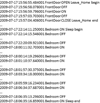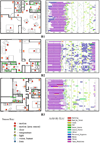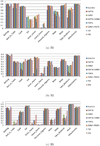Activity Recognition on Streaming Sensor Data
- PMID: 24729780
- PMCID: PMC3979570
- DOI: 10.1016/j.pmcj.2012.07.003
Activity Recognition on Streaming Sensor Data
Abstract
Many real-world applications that focus on addressing needs of a human, require information about the activities being performed by the human in real-time. While advances in pervasive computing have lead to the development of wireless and non-intrusive sensors that can capture the necessary activity information, current activity recognition approaches have so far experimented on either a scripted or pre-segmented sequence of sensor events related to activities. In this paper we propose and evaluate a sliding window based approach to perform activity recognition in an on line or streaming fashion; recognizing activities as and when new sensor events are recorded. To account for the fact that different activities can be best characterized by different window lengths of sensor events, we incorporate the time decay and mutual information based weighting of sensor events within a window. Additional contextual information in the form of the previous activity and the activity of the previous window is also appended to the feature describing a sensor window. The experiments conducted to evaluate these techniques on real-world smart home datasets suggests that combining mutual information based weighting of sensor events and adding past contextual information into the feature leads to best performance for streaming activity recognition.
Keywords: activity recognition; mutual information; online; real-time; streaming.
Figures









References
-
- Cook D, Schmitter-Edgecombe M, Crandall A, Sanders C, Thomas B. Collecting and disseminating smart home sensor data in the casas project. Proceedings of the CHI Workshop on Developing Shared Home Behavior Datasets to Advance HCI and Ubiquitous Computing Research. 2009
-
- Cook DJ, Youngblood M, Heierman E, Gopalratnam K, Rao S, Litvin A, Khawaja F. Mavhome: An agent-based smart home; Proceedings of the International Conference on Pervasive Computing; 2003.
-
- Intille S, Larson K, Tapia EM, Beaudin J, Kaushik P, Nawyn J, Rockinson R. Using a live-in laboratory for ubiquitous computing research. Proceedings of Pervasive. 2006:349–365.
-
- Krse BJA, Kasteren TLMV, Gibson CHS, den Dool TV. Care: Context awareness in residences for elderly; Proceedings of Sixth International Conference of the International Society for Gerontechnology; 2008.
-
- Kidd CD, Orr RJ, Abowd GD, Atkeson CG, Essa IA, Mac-Intyre B, Mynatt E, Starner TE, Newstetter W. The aware home: A living laboratory for ubiquitous computing research; Proceedings of the Second International Workshop on Cooperative Buildings; 1999.
Grants and funding
LinkOut - more resources
Full Text Sources
Other Literature Sources
Miscellaneous
